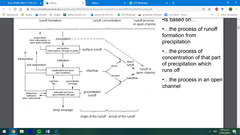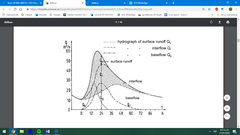- Barajar
ActivarDesactivar
- Alphabetizar
ActivarDesactivar
- Frente Primero
ActivarDesactivar
- Ambos lados
ActivarDesactivar
- Leer
ActivarDesactivar
Leyendo...
Cómo estudiar sus tarjetas
Teclas de Derecha/Izquierda: Navegar entre tarjetas.tecla derechatecla izquierda
Teclas Arriba/Abajo: Colvea la carta entre frente y dorso.tecla abajotecla arriba
Tecla H: Muestra pista (3er lado).tecla h
Tecla N: Lea el texto en voz.tecla n
![]()
Boton play
![]()
Boton play
![]()
65 Cartas en este set
- Frente
- Atrás
|
Why it is important to estimate the Age of GW?
|
Modern GW is the biggest resource in the active cycle. Estimating the young GW content in an aquifer helps understand the recharge rates, the residence time and some important dynamics for the GW.
|
|
What is the water footprint of humanity?
|
Of the water consumed:
74% (green) comes from rain recharge 11% is blue, comes from GW/Surface 15% is grey, non-fecal WW (recirculation) |
|
Biggest water consumption?
|
Production of food: Cereals meat and dairy.
--- Most countries "import" water. |
|
Why is modelling and monitoring so important to prevent the consequences of drought?
|
It helps to identify vulnerabilites, and allow for better adaptation measures, because it helps to predict evapotranspiration and behavior of water bodies and aquifer in drought periods.
|
|
How can Particle size distribution serve as an indicator of fecal bacteria?
|
Foreign (Allochtonous) turbidity coincides with elevated fecal bacteria presence. Because of bacteria adherence to surfaces. Increase of finer particles means foreign turbidity and should be used within the criteria for water rejection after a rain event.
|
|
Explain the behavior of GW in barrier islands.
|
GW is vulnerable, older water tend to accumulate at the limits with seawater, younger water is closer to recharge areas. But, Climate change alters the behavior and the isotropic and chemical composition.
|
|
Name 5 risks from to water ressources from Fracturing?
|
1-Contamination of aquifers with gases
2-Conatmination of surface and GW with spills 3-Accumulation of toxic and radioactive elements in soils 4- overextraction of water resources for the fracking But-"direct"contamination remains controversial |
|
Importance of Deep understanding deep GW in Germany
|
It is important to plant nuclear disposal sites. To have certainties about the dynamics in the aquifers it is important to characterize this deep-lying aquifers. As well as to plan possible sytes to harvest geothermal energy, or to store Co2, or to extract water avointing contaminated shallow aquifers.
|
|
About the Fluvio Lacustrine Environment in March...
|
Curiosity discovered fine-gainde sedimentary rocks in March. Typical rocks that form in presence of water. The sediment analysis suggest the lake had good chemical characteristics that could have supported life.... but it didn't last long
|
|
Use of Gd as a tracer
|
Good tracers, because of well known temporal behavior.... (weekdays a lot, weekends downs) It ocurse tranciently, and the peaks can be used to derive GW transit times.
|
|
Fiber-Optic temperature sensing tech
|
USing the relation between density, temperature and transmiting capacity of optic fibers, cables that are already installed at lake bottoms can be used to keep track of the mtemperature.
Used in lake bottoms, first order streams, and air-water interface. |
|
Residence time and reservoirs of water
|
Oceans 97% up to 4000 a
Glaciers 2% 1000 a Subsurface 0,6% 10000 years lakes <0.1% 10yrs salty lakes <0.1 Air <0.001 10 days Rivers 2 weeks |
|
How to measure Precipitation
|
Rain Gauge/ Colecting vessel (Helmann)
Errors: wind, evaporation With a satellite |
|
How to measure ET
|
Directly: Class-A-Pan
Indirectly: Lysimeter (weight) Empirical with climate data (ETP de Thornthwaite) |
|
Runoff
|
Discharge gauge in rivers
|
|
General balance equation of a system
|
I=O+dS/dt
(Input = output + delta storage) |
|
Water cycle eq
|
P = ET + Qdischarge + DeltaS
|
|
Types of precipitation
|
Falling (Condensation)
Liquid: Mist Rain Solid: Snw Hail |
|
Definiton of wet and Dry year
|
Wet:
Year in which the height of precipitation exceeds the mean value by at least the standard deviation |
|
How to "Regionalise the precipitation"
|
Using Thiessen Polygons
(Drawing contour lines around a precipitation measurements and weghting the rate of precipitation by area) But: doesn't work for areas with strong relief Using Isohyet isohieta es una isolínea que une los puntos en un plano cartográfico que presentan la misma precipitación en la unidad de tiempo considerada. |
|
Possibilities for determination of natural recharge:
|
Water balance (runoff)
Soil water balance Data from water works GW discharge Runoff in receiving streams With tracers Lysimeter |
|
Runoff process
|

|
|
Types of runoff (and where do they appear)
|
Surface runoff (surface)
Interflow (unsaturated soil) GW- Runoff (water saturated ground) |
|
Interflow
|
Part of the runoff which flows to the receiving stream as a reaction to a trigger event
it is slower with respect to surface runoff |
|
Total runoff (Q)
|
QD direct runoff (surface runoff + interflow)
+ Qb baseflow ( |
|
Composition of a hydrograph
|

.
|
|
Effluent and influent conditions
|
Effluent: Water infiltrates, river level above water table
Influent: Water effiltrates to the river, river level below water table |
|
What is the Mo MNQ method
What is the Kille method? |
Methos for statistical analysis of water discharge using long-term data
|
|
Maillet method, what is it used for? and Forumla
|
For recession analysis (decline of discharge in the absence of input)
Qt = Qo e^-alphaDt Qt= discharge at the time t after the recession started Qo= discharge at beggining alpha: coefficient of discharge alpha= Qt/Vt (Discharge at time t / Sorage at time t) Qo = discharge |
|
Discharge measurement. Methods?
|
-Weir (presa) measurement
-Salt dilution method -Vessel measurement -Determination of flow velocity (hidrología) - Level measusrement |
|
Evaporation depends on 4 factors:
|
-Difference between vapor pressure at the surface and vapor pressure of air nea the surface
- Energy which is available at the surface - Amount of vapor removed with air Amount of water available |
|
ET=
|
Interception (retention by plants)
Evaporation Transpiration |
|
% of ev interception and transpiration in ET
|
Green land 15 ET 25 Inter 60 Transpiration
|
|
What is porosity?
|
The available amount of empty space en a sediment
(the total volume of cleavages (hendiduras) n= Vp/Vg |
|
effective porosity
|
ne = Vp (that is crontributing to gw movement)/Vs
|
|
Usual values of porosity
|
Sandstone 5-35%
Karst 30-50% |
|
Effective porosity by sediment
|
clay < 5%
fine sand 10-20 medium 12-25 coarse 15-30 fine gravel 15-25 |
|
Isohypse (isohipsa)
|
Una isohipsa es en meteorología una línea de igual altitud de geopotencial sobre una superficie dada
|
|
Hoy is a isohypse map constructed?
|
With hydrological triangles, around water head measurement points.
|
|
Hydraulic level
|
(aka Gauge level) gives the potential energy with the dimension of water on each location of the flow net.
It depends of elevation energy and pressure |
|
Groundwater potential analysis can be used for
|
flow direction, general picture
identify recharge and discharge zones hydraulic conectivity sea intrution areas |
|
Important information every hydrogeologist need?
|
-GW flow velocity
- Contaminant transport velocity - How much water can be pumped from a well - dropdown ------ for it only h is needed!! |
|
What is the relation between groundwater flow rate and groundwater level?
|
• Q is directly proportional to the flow through an area (A)
• Q is inversely proportional to the flow length (l) • Q is directly proportional to the pressure gradient (Δh) • additionally there is a rock specific proportionality factor: kf , the hydraulic conductivity |
|
Typical Kf values....
|
Gravel 10-2
Sand, core 10-3 Sand 10-4 Sand, fine 10-5 Clay 10-8 |
|
What is permeability?
|
permeability K is a rock specific measure for the permeability for fluids
and gases. It has the unit [m²] and is a measure as the resistance, that the porous medium (and not the fluid itself) opposes to the movement of the fluid. The higher the permeability, the lower is the flow resistance! |
|
Factors affecting hydraulic conductivity?
|
permeability density and viscosity of water
|
|
The flow assumed in darcy is....
|
linear!!!
for turbulent flows>> reynolds number |
|
hydraulic gradient in unconfined aquifer's formula?
|
Depuit: i= h1^2-h2^2/2l
|
|
Horizontal and vertical hydraulic conductivity
|
Generally the vertical hydraulic conductivity is smaller than the horizontal
hydraulic conductivity due to layering |
|
What is transmissivity?
|
it gives the volumetric flow rate through a cross sectionf of the aquifer which is perpendicular to the flow direction. CS is 1m wide and comprises the whole thickness
|
|
Storativity
|
Capacity of containing water
|
|
Storativity in a confined aquifer represents:
|
The water released from descompression of water and from descrompression of matrix
|
|
Storativity in an unconfined aquifer represents:
|
The drainable porosity: water volume released by gravity by crearing out of the pores!
|
|
What is the use of a pumping test?
|
Determination of hydrogeologic
parameters of the aquifer! – Transmissivity – Storativity |
|
Name types of pumping tests:
|
- Drawdown area
(Area in which drawdonw of the table is observed) - Extraction area Part of the drawdown area from which water flows to the well - Extraction width Distance between intersections of the border of the subsurface catchment |
|
Hydrogeologic Pumping test (T,S)
how much time needed? |
3 days to 4 weeks!
|
|
Flow regimes....
|
Transient: hydraulic head changes with time
Steady state: hydraulic head is consant |
|
Preparation of a pumping test
|
Hydrogeological maps, geological maps
• Monitoring network (observation wells) • Water level before pumping test (if available historic water tables) • Composition of groundwater • Lateral extension and thickness of the aquifer • Determination of boundary conditions (afflux, boundaries, leakages influence on cone of depression) • Administrative preparation, application at the responsible water authorities • Country specific water laws |
|
Requirements on an aquifer and pumping well:
|
- Aquifer extension indefinite
aquifer homogenic, isotropic - thickness constant - pumping test is carried out with constant pumping rate no influx/outflux - the well is complete |
|
Formula for pumping test-confined
|
Thiem: Q=k * i * A
h2-h1= Q/ 2piT * ln(r2/r1) |
|
Formula, unconfined pumping test
|
Dupuit thiem: Q = 2 pi r h kf dh/dr
h2^2-h1^2= Q/ pi kf * ln (r2/l1) |
|
3 stages of a pumping test
|
I starting regime
II transient conditions III steady state |
|
Pumping test: transient flow formula:
|
Theis + Cooper&Jacob
Theis: Curve procedure cooper Jacob: T 2,3Q/S pi Ds |
|
What is an slug and bail test?
|
method for a single well which is carried out in a
piezometer or small-diameter monitoring well (Standrohr). A displacer (Verdrängungskörper) is released into the well hydraulic head rises |
|
Application of slug – and bail tests vs Pumping tests
|
Brownfield sites (no extraction of contaminated water)
•Short duration of the test compared to pumping test •Lower costs •Lower material effort |